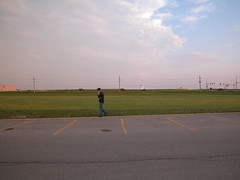What is outside?

Originally uploaded by .Kerri..
Thinking about how figures like Loie Fuller and Henry Darger have captured my attention lately and if their Chicago backgrounds are just a coincidence. Or is there something sub/unconsciously Chicagoan or Midwestern about their work that I'm drawn to? (When I haven't yet articulated to myself what it means to be "Midwestern", a question also posed by Ray in my interview for ChicagoPostmodernPoetry.com) How about the fact that they're both considered outsiders? -Fuller has apparently been written off as a passing Art Nouveau fancy by modern dance historians...because she wasn't classically trained? Or because she appealed to more populist audiences and venues like the burlesque circuit? Talking about this last night with J who said, "Well, the arts can be prissy that way...The music world still has a hard time accepting Satie, because he was the bar room piano guy." Bang. Another personal fav. (His quote, "The more people I meet the more I like dogs" sticks with me on those occasions like yesterday's bobble-head lady.)
Well, Satie did have some informal piano training and he did go to the Paris Conservatoire for a few years before discontinuing his studies because his professors were of the opinion that he had no talent, but Darger and Fuller more or less intuited the rudiments of composition as it applied to their disciplines, Darger especially in discovering on his own the techniques of collage, transfer, photo enlargement, etc. Fuller is quite respected in the history of theatrical lighting and early cinema for her innovative "special effects" involving colored gels over electric lights, a spanking new invention in her time.
Then we were talking about the problem the art world seems to have with collaborative work. J has spent years of grad school frustrating his critiquers with his collabotive projects...they routinely insist on knowing which parts he "did"...and have warned him that getting hired may be difficult if a committee can't parse out what he's contributed as an individual to a creative body of work. But isn't this insistence of artistic ownership primarily a corollary to commodification? A work needs authorship to have taxonomic value because market value relies on an artwork/artist having a determinable place in a context like a canon. Perhaps. Thinking then of "successful" multimedia art/artists who have transcended the difficulties the art world has with such works that by nature challenge traditional modes of exhibition and purchase, like Bill Viola or Vito Acconci, who of course have to employ an army of underlings to realize the work (I know at least one)...at what point do these people's ideas form a collaboration? And it seems that artists like Viola and Acconci have risen above a lot of other quality work because they have managed to project a singular identity/persona of work/artist that is immediately graspable (and intoxicating) to curators and collectors. Carolee Schneeman too. I wasn't too impressed by a lecture she gave last fall at Northwestern, and I've never felt very engaged by her performance works, either in concept or realization. But as she was talking I could appreciate why the art world liked her work. It bore a singular identity that fit conveniently into the timeline. Happenings. Drug culture. Feminism. Schneeman.
So is it that Midwesterners just don't by nature possess the dandyism that is a prerequisite to attracting the notice of so-called "legitimate" tastemakers?
0 Comments:
Post a Comment
<< Home